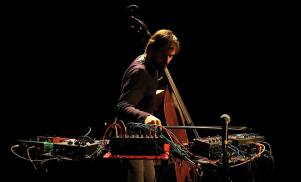Stream the self-titled album now.
In a video of his performance at last year’s Bozar Electronic Arts Festival, Brussels-based artist Otto Lindholm stands before an imposing collection of analog gear armed with a double-bass taller than he is. It’s an incredibly striking image and gets across the struggle between electronic and acoustic that his self-titled debut album captures so well.
The music makes him think of a large body of water and true to that analogy, his work can shift from tranquil to terrifying with the unpredictability of the open seas. Chilling acoustic bass tones loop through electronic processing in a stormy swirl — at once dangerous and stunningly beautiful — with their perpetually calm creator in the eye of it all. Otto Lindholm is an appropriate name for an album that acts as such a singular self-portrait.
The album is out next week, March 25 via Icarus Records, but you can stream it in full below and read our conversation with Lindholm about his work and where he’ll take it next.
Did you have an initial idea that you wanted to explore on this album?
This album is the first result of a long maturation process that I began years ago as a solo bass player. To this end, I was faced with a double challenge. First, I was looking for a personal analogic set-up, an extension of my double bass, so to speak. This setup had to give me freedom and ergonomics in my creativity and at the same time, sufficient complexity in terms of production and playing. Secondly, at this time, I was exploring my own musical aesthetic, a pictorial music that attempts to contemplate through the use of power and lyricism. After that, this album developed intuitively out of an organic dialogue between the double bass and the machines. In the album’s three long musical pieces, ‘water’ appears to be common denominator, its darkness and calmness offering me large territories to explore, maybe in reminiscence of my emblematic ancestor Otto W. Lindholm, a 19th century Finnish explorer who literally travelled more than 10 times around the globe.
Your set-up live is so physically demanding — did you build up to that point gradually where you were performing so many things at once?
I love loop stations, they are my wizards. They allow me to instantly pick out a moment. I have always worked with hardware and analogic machines, you know, turning knobs and foot controllers. In fact, hardware gives me the first creative frame. And the truth is that I don’t understand computers and I’m too lazy to understand them. This whole story began when I tried to get around the rigidity of loop stations — something more than simply a long crescendo based on one loop of 2 bars. Adding more and more machines, I discovered the fantastic world of desynchronization in which these loop stations began to live on their own. Currently, I’m working with six machines simultaneously; if I change one effect, my entire world is completely different. I needed to be extremely focused on the process and to spend a lot of hours practising to learn how to ‘play’ this homemade ‘instrument’. Only after this was I able to play with it and finally interpret the music live.
“The fun arrives when I discover new material in the moment on stage”Otto Lindholm
Do you approach your music differently in recording than when you’re performing? How do those two environments vary?
I think they are the two faces of a same coin. I recorded this music much in the same way I play a concert; I recorded all the material at one time. I have always placed huge importance on the ‘play’ mode, the so-called intention. The big difference between a live performance is the non-presence of an audience; essentially the moment I have to deliver the music is the difference. In the studio, I can play the same material for hours and then, listen to it again, and then choose a version or a dedicated moment. On the other hand, live, the audience is physically present and expects something to be achieved instantly. The big deal for me is to be able to grab their attention at the very beginning and have them travel with me. For a live show, I prepare my set by choosing a specific set-up I am comfortable playing with. The fun arrives when I discover new material in the moment on stage and share it directly with the audience.
What are your plans for later this year following the release of the album?
Playing live, traveling and meeting people; that’s one of the benefits to playing alone: you always meet very inspiring people. And of course I will still continue to write and record material. Currently, I am working on a new release inspired by the story of Antigone or, more broadly, the tragedy. Touring and playing, meeting people, writing, recording, and loop it again!






































